There are 17 species of turtles in Kentucky, roaming the wilds of the Bluegrass State. You may find giant Snapping turtles in muddy waters, or Softshell turtles in clear running streams. You could also find a Box turtle roaming the mountains.
The wild, untamed state of Kentucky is famous for the iconic fried chicken (KFC stands for Kentucky Fried Chicken), the Louisville Slugger baseball bat, moonshine, the Kentucky Derby, and was even the home of the great boxing slugger Muhammad Ali.
All of these things are great, but even better are all the species of turtles you can find here. The water is fine and full of turtles so let’s dive straight in.
Table of Contents
Softshell Turtles in Kentucky
There are two softshell turtles endemic to the state of Kentucky. These include the Midland Smooth Softshell and the Spiny Softshell turtle.
1. Midland Smooth Softshell

- Experience level: Intermediate
- Family: Trionychidae
- Scientific Name: Apalone Mutica
- Other Names: N/A
- Average Adult Size: 5 – 14 inches
- Life Span: 10 – 20 years
- Average Price Range: $50 – $150
- Conservation Status: Least Concern
The Midland Smooth Softshell turtle has a soft and smooth carapace (fancy name for the upper part of a turtle’s shell) leathery or rubbery. That is if you can get close enough to touch them. They can be aggressive out of the water, and what’s more, they are very fast on land.
Smooth Softshell turtles prefer swift moving, clear waters with muddy or sandy bottoms. They also prefer to stay in shallow water so they can sit on the bottom and only stretch their long necks up to get a breath of air.
Softshell turtles can stay submerged for a very long time because they can actually absorb oxygen from the water through their skin.
These turtles are sandy beige, tan, or dark brown in an effort to blend in with the sandy, muddy water bottom. They also stay submerged in the water and wait for food to come to them, but they can also be active hunters.
Softshell turtles eat insects, fish, amphibians, crayfish, occasional carrion, and some vegetation.
This turtle is listed as least concern federally but is considered threatened in the state of Kentucky. This means the state sees their numbers dwindling and may become endangered or extinct if conservation efforts are not put into progress.
2. Spiny Softshell Turtle
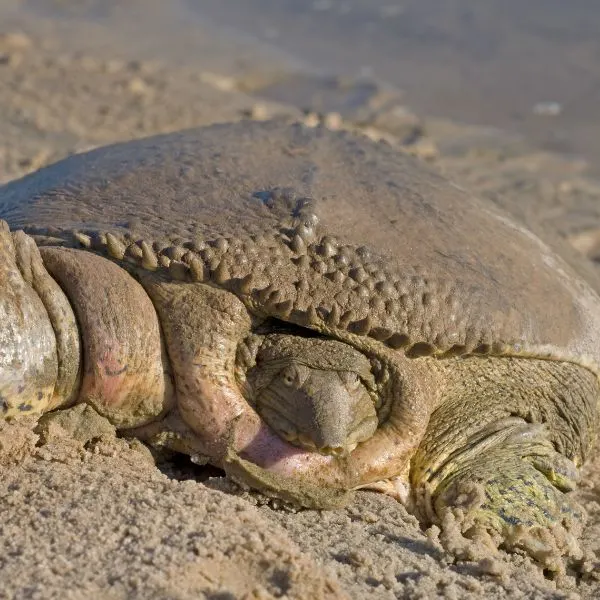
- Experience Level: Intermediate to Expert
- Family: Trionychidae
- Scientific Name: Apalone spinifera
- Other Names: N/A
- Adult Size: 5 to 9 ½ inches for males, 10 to 20 inches for females
- Life Span: Between 20 and 50 years
- Average Price Range: Between $20 and $120
- Conservation Status: Threatened in some areas
The Spiny Softshell turtle is quite similar to the Smooth softshell except that they have fleshy nodules on the front of their carapace. These sandpaper feeling bumps can extend halfway down the carapace.
It is usually brownish on the carapace with dark spots/blotches which can fade as the turtle ages. They have a white, small plastron (the name of the bottom part of the shell).
Softshell turtles experience extreme sexual dimorphism (meaning a big difference among the same species). Females are much bigger than males. Sometimes they can grow as much as three times as large as the men of this species. Imagine we were the same, men would be dating women 15 to 20 feet tall!
Like the Smooth Softshell, the spiny version likes lakes, streams, rivers, and ponds with little vegetation and sandy or muddy bottoms. They too eat mostly meat sources, but will occasionally feed on vegetation and algae.
Snapping Turtles in Kentucky
There are two snapping turtles native to Kentucky. These are the Common Snapping turtle and the Alligator Snapping turtle.
3. Common Snapping Turtle
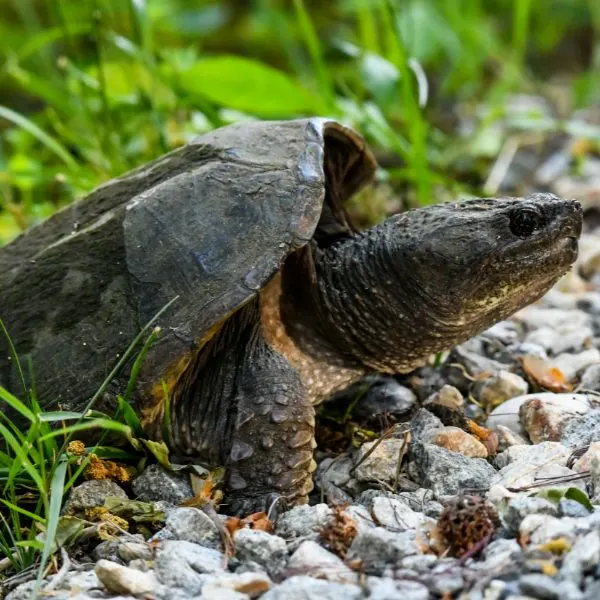
- Experience level: Intermediate to Expert
- Family: Chelydrida
- Scientific Name: Chelydra Serpentina
- Other Names: Snapping Turtle, Snapper, Eastern Snapping Turtle
- Average Adult Size: 8 to 20 inches
- Life Span: 30 – 50 years
- Average Price Range: Approximately $40 to $120
- Conservation Status: Least concern
The Common Snapping turtle is a rugged-looking turtle with a distinct looking shell. It’s thick, dark colored, and often covered in mud or algae. You may see three ridges along the back end, but these fade the older the turtle gets.
They have a long tail that is almost as long as their body, along with long stout-looking limbs. They also have a long neck and wide head. These turtles don’t mind showing how sharp and big their mouths are when they are approached.
They will hiss, and if that doesn’t send you backing up, they will try to bite. Don’t mess with these bad boys and girls, they can hurt you. In the water though, they are much more passive and prefer to hide or get away rather than stand their ground.
These turtles prefer waters that are slow moving and have muddy bottoms. They will spend most of their time underwater and sometimes even bask by just coming to the surface.
As you might expect, these turtles are mainly carnivorous. They will eat nearly anything they can get into their huge mouths. They have also been observed eating algae and the occasional plant.
4. Alligator Snapping Turtle

- Experience level: Expert
- Family: Chelydrida
- Scientific Name: Macrochelys temminckii
- Common Name: Loggerhead Snapper
- Average Adult Size: 13-30 inches
- Life Span: 30 – 50 years
- Average Price Range: Approximately $50 to $300
- Conservation Status: Threatened
The Alligator Snapping turtle is similar to the Common Snapping turtle, only it looks like it refused to evolve for millions of years. They have a spiked carapace, grow much bigger, and their skin is covered in pointy tubercles.
They have a saw-toothed, long tail, and cannot pull themselves into their shells. Their heads are even bigger and more threatening than Common Snappers. Alligator Snappers have a much harder bite, up to 1,000 pounds of pressure.
These aggressive turtles are more docile in the water. Here they tend to lie on the bottom and wait for food to come to them. They have a worm-like projection on their tongue that helps to bring prey closer. When food gets close enough the Alligator Snapping turtle darts its head out and chomps down on the fish, frog, amphibian, or even smaller turtles.
Alligator Snapping turtles can be found in muddy lakes, stagnant swamps, slow-moving rivers, and occasionally brackish water.
Mud and Musk Turtles in Kentucky
5. Eastern Mud Turtle

- Experience Level: Beginner
- Family: Kinosternidae
- Scientific Name: Kinosternon subrubrum
- Other Names: Common mud turtle
- Adult Size: 3 to 4 inches
- Life Span: 40 to 50 years
- Average Price Range: $20 – $100
- Conservation Status: Least concern
These small turtles tend to be elusive as they don’t like to leave the water. They have a solid colored shell with no patterns. It’s usually brown but can be olive or black with a brown plastron with black lined scutes.
On the rare occasions, they are out of the water they can be aggressive and try to bite. Much like musk turtles, mud turtles also have musk glands that can emit an offensive odor when they are threatened.
They also have a double hinged shell and can completely close themselves into the shell to protect themselves from predators.
As their name suggests, the Eastern Mud turtle likes muddy waterways. These include small ponds, slow-moving streams, swamps, bogs, and drainage ditches.
The Eastern Mud turtle is an omnivorous species. They will eat fish, crayfish, insects, snails, slugs, and aquatic vegetation.
6. Mississippi Mud Turtle

- Experience level: Intermediate
- Family: Kinosternidae
- Scientific Name: Kinosternon subrubrum hippocrepis
- Other Names: N/A
- Average Adult Size: 5 – 7 inches
- Life Span: 25 – 45 years
- Average Price Range: $40 – $80
- Conservation Status: Least Concern
A subspecies of the Eastern Mud turtle, the Mississippi Mud turtle looks similar to the aforementioned turtle, but they get nearly twice as large. Their carapace is similar in color and is lacking in markings.
The plastron on the other hand is a brighter yellowish color and hinged, though the Mississippi Mud turtle can’t close itself in completely.
These turtles prefer slow-moving waters, preferably with plenty of vegetation and soft, muddy bottoms. While they are rarely seen basking, they do often leave the water and frequently try to cross roads.
They have a high mortality rate along the roadsides, so be careful and keep an eye out when driving around Kentucky.
Mississippi Mud turtles are omnivores that will eat worms, mollusks, fish, insects, nuts, berries, and other vegetation.
7. Eastern Musk Turtle
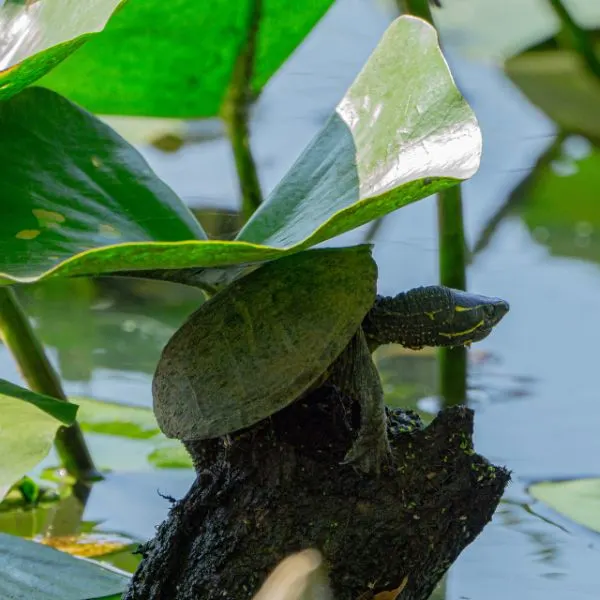
- Experience Level: Intermediate
- Family: Kinosternidae
- Scientific Name: Sternotherus odoratus
- Other Names: Common Musk turtle, Stinkpot
- Adult Size: 4 to 5 inches (10 to 12.5 cm)
- Life Span: 30 to 50 years
- Average Price Range: $30 to $120
- Conservation Status: Least concern
The Eastern Musk turtle is a very small turtle with a highly domed blackish-brown carapace. There are two parallel yellow stripes that run from the snout to the neck.
Although all musk turtles are able to release a nasal assault in the form of musk, this turtle gains the moniker the Stinkpot.
These turtles tend to stay along the bottom of the water and use abundant vegetation to climb to the surface for air. It’s not often that these turtles will bask, but they can climb trees.
When branches reach into the water, these turtles don’t have a problem climbing up in the search for food. In the trees, they will eat spiders and other insects.
Stinkpots also eat berries, seeds, mollusks, tadpoles, fish, and leeches.
You’ll find these turtles in ponds, lakes, streams, ditches, swamps, and other slow moving permanent bodies of water.
Painted Turtles in Kentucky
Painted turtles all have stripes of color on their head, neck, and limbs. Sometimes it’s difficult to tell these species apart, but there are small differences you may notice if you’re lucky enough to get closer to these turtles.
8. Southern Painted Turtle

- Experience level: Beginner
- Family: Emydidae
- Scientific Name: Chrysemys dorsalis
- Other Names: Painted Turtle
- Average Adult Size: 4 – 6 inches
- Life Span: 20 – 25 years
- Average Price Range: $30 – $150
- Conservation Status: Least Concern
The Southern Painted turtle has a smooth, dark colored, slightly domed carapace that flares out at the edges. These turtles look very streamlined. Speaking of lines, Southern Painted turtles have a yellowish to reddish stripe along the middle of the shell running from front to back.
Their plastron is either yellow or tan and may have a dark smudge along the middle. Their skin is dark green to black with yellow, orange, or reddish stripes.
Waterways you’re likely to find these turtles include oxbow lakes, streams, ponds, and swamps. They prefer a home with a lot of plants and soft, muddy bottoms.
Southern Painted turtles eat insects, mollusks, crayfish, duckweed, and algae.
9. Midland Painted Turtle
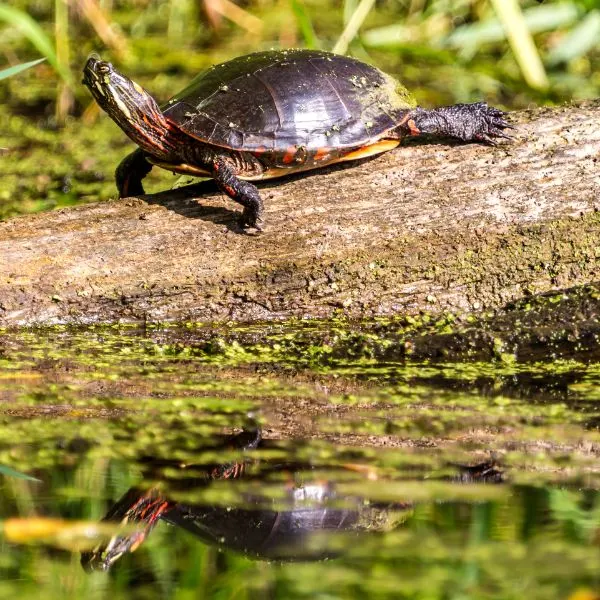
- Experience Level: Beginner
- Family: Emydidae
- Scientific Name: Chrysemys picta marginata
- Other Names: N/A
- Adult Size: Between 4 and 10 inches
- Life Span: Between 30 and 50 years
- Average price range: Between $30 and $150
- Conservation Status: Special concern
The Midland Painted turtle has an olive to black colored carapace with markings along the marginal scutes. The rest of the upper shell is patternless. The plastron is yellow or tan and sometimes has a “butterfly type” pattern that runs along the middle.
Did you ever fold a piece of paper in half, paint on one side then fold the paper together and then pull it apart? That’s what the carapace of Midland Painted turtles looks like.
Midlands grow a few inches larger than the small sized Southern Painted turtles. Midland Painted turtles can reach up to 10 inches long. They also have yellow stripes along the skin.
These turtles inhabit streams, ponds, and marshes with plenty of basking spots. Painted turtles love to bask and several may be seen on single, small basking sites. When disturbed they will all eagerly take to the water.
These turtles are opportunistic omnivores. They feed on algae, vegetation, carrion, tadpoles, insects, and many other aquatic invertebrates.
Map Turtles in Kentucky
10. Northern Map Turtle
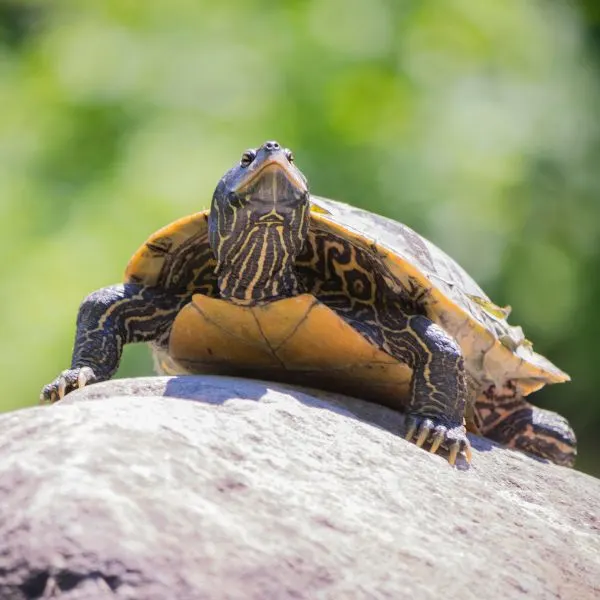
- Experience Level: Beginner
- Family: Emydidae
- Scientific Name: Graptemys geographica
- Other Name: Common map turtle
- Adult Size: Between 4 and 10 ½ inches
- Life Span: 15 to 20 years
- Average price range: Between $20 and $60
- Conservation Status: Least concern
All of the species of Map turtles found in Kentucky are very similar to one another. They look nearly identical to one another aside from a few minor characteristics that are hard to determine unless you’re able to get close. We’ll tell you the most defining characteristics of the species.
These turtles are all quite elusive and shy, so you may not even see them. You’re only indication that a turtle was near would be the expanding ripples where it deftly slid into the water to hide from you.
They are all omnivorous and eat insects, mollusks, vegetation, and other meat sources. Map turtles have yellowish patterns on their olive to grey carapaces that resemble the markings on a map.
They also have a darker ridge or keep running front to back. Some have larger nodules than other species, but these ridges often smooth out and fade as the turtle ages. Map turtles also have saw-toothed ridges along the back of the shell, giving some of them the nickname “sawback turtle.”
The skin on these turtles ranges from olive green to dark brown, or even black, and they all have yellowish or white stripes. The main distinguishing characteristics of these turtles are the markings on their heads.
Map turtles prefer larger bodies of water such as lakes, large rivers, and wide streams.
The Northern Map turtle has a J-shaped line on the lower side of the neck. It tends to slant upward as it gets nearer the head. These markings are very tough to see unless you’re able to get very close to the turtle.
11. Ouachita Map Turtle

- Experience Level: Beginner
- Family: Emydidae
- Scientific Name: Graptemys ouachitensis
- Other Names: Southern Map turtle
- Adult Size: 3.5 to 10 inches (9 to 25.5 cm)
- Life Span: 15 to 20 years
- Average Price Range: $40 to $100
- Conservation Status: Least concern
The Ouachita Map turtle is distinguished by wide yellow markings behind each eye. The neck stripes may or may not touch the lower eyes, but you will see another sizeable yellow spot under each eye.
12. False Map Turtle
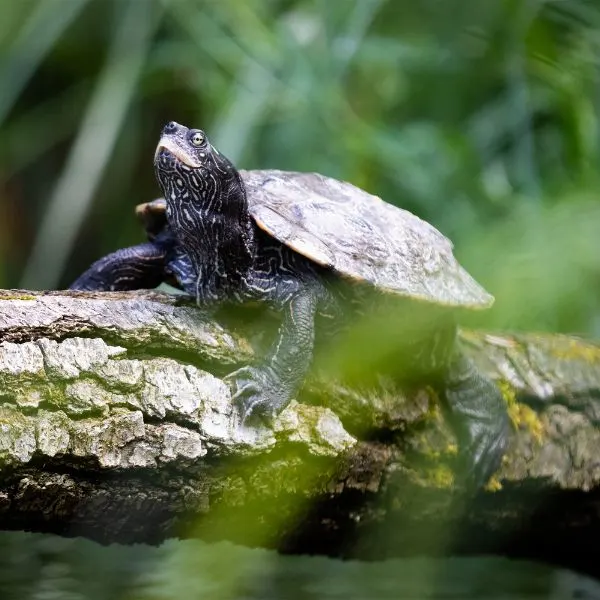
- Experience Level: Beginner
- Family: Emydidae
- Scientific Name: Graptemys pseudogeographica
- Other Names: Sawback turtle
- Adult Size: 3.5 to 10.5 inches (9 to 26.5 cm)
- Life Span: 30 to 50 years
- Average Price Range: $6 to $40
- Conservation Status: Least concern
The False Map turtle has an L-shaped marking behind each eye. To further identify this turtle, look for yellow lines that run from the neck and touch each eye. Also, look for a yellow spot under the eyes and another near the tip of the chin.
13. Mississippi Map Turtle

- Experience level: Intermediate – expert
- Family: Emydidae
- Scientific Name: Graptemys pseudogeographica kohni
- Other Names: Sawback Turtle
- Average Adult Size: 5 – 10 inches
- Life Span: 30 – 50 years
- Average Price Range: $30 – $130
- Conservation Status: Least Concern
The Mississippi Map turtle should have a larger, yellow crescent behind each eye. There are slight color variations in the shell, and the midline ridge on these different turtle species varies a little between them. Other than that, it’s pretty difficult to tell one Map turtle species from another.
Cooters in Kentucky
14. Eastern River Cooter
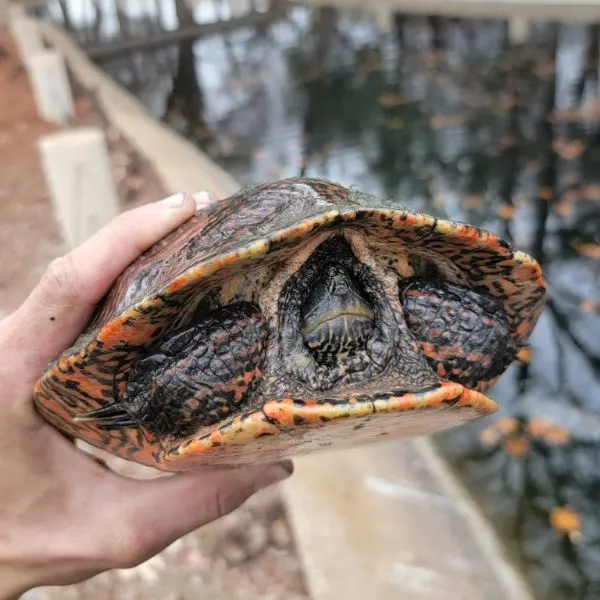
- Experience Level: Beginner to Intermediate
- Family: Emydidae
- Scientific Name: Pseudemys concinna concinna
- Other Names: River Cooter
- Adult Size: Between 8 and 12 inches
- Life Span: Between 20 and 40 years
- Average Price Range: $20 to $50
- Conservation Status: Special concern
The Eastern River Cooter is a medium to large turtle. They average around 10 to 12 inches but do rarely grow up to 16.5 inches. They have highly patterned and alternating carapaces as juveniles.
The colors of juvenile shells can be yellow, orange, red, green, black, and brown. As they age, the shell darkens and the patterns are less distinct. They have a single keel that also smooths out over time.
Their plastron is pale yellow to tan and may have a midline pattern. The River Cooter’s skin is olive, brown, or black with yellow to white stripes.
As their name suggests you’ll often find these turtles in rivers, but they have also been found in ponds, lakes, and streams. The main habitat criteria seem to be a multitude of basking spots and abundant vegetation.
The Eastern River Cooter is mainly herbivorous, but occasionally eats insects, mollusks, and other protein sources. Juveniles are mainly carnivorous as they need the protein to grow big faster. Reptiles often grow slower than mammals, and baby turtles are a nice snack for a multitude of predators.
15. Hieroglyphic River Cooter
- Experience level: Beginner to intermediate
- Family: Emydidae
- Scientific Name: Pseudemys concinna hieroglyphica
- Other Names: N/A
- Average Adult Size: 5 – 13 inches
- Life Span: 15 – 20 years
- Average Price Range: $120 to $180
- Conservation Status: Endangered
The Hieroglyphic River Cooter is very similar to its Eastern cousin. They have a very similar looking shell, and skin. The Hieroglyphic sometimes tends to get larger than the Eastern, and they may have a Y shaped stripe under their chin.
Hieroglyphs live in large, free running rivers with a lot of vegetation as they are also mainly herbivores. They like to bask but will quickly disappear into the water whenever they notice movement.
Once they are in the water, River Cooters can stay submerged for a long time because they can absorb oxygen from the water.
Pond Sliders in Kentucky
16. Red Eared Slider
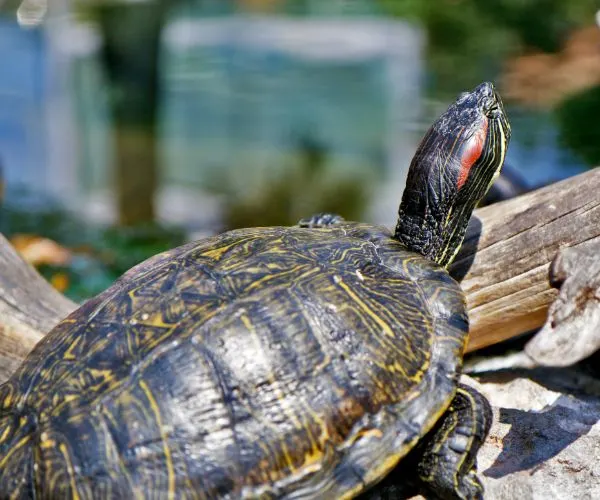
- Experience level: Beginner
- Family: Emydidae
- Scientific Name: Trachemys scripta elegans
- Common Name: Pond slider, Red-eared terrapin, Water slider
- Average Adult Size: 6 – 8 inches
- Life Span: 20 to 40 years
- Average Price Range: approximately $30 to $100
- Conservation Status: Least concern
The Red Eared Slider is one of the most popular turtles around the world both as pets and as a food source. Many cultures around the world still eat turtle meat. America was once no different, but over time, turtle dishes lost popularity.
There are still a few places in the United States where you can find turtle soup and other meals featuring turtle meat.
Enough about that, the Red Eared Slider is a medium sized aquatic turtle that has a colorful carapace, and a yellow to tan plastron with black spots. It has dark green to black skin with yellowish stripes similar to painted turtles.
The main distinguishing characteristic of Red Eared Sliders is the red, oblong ovals behind each eye. This gives these turtles the appearance of ears. These turtles are the only ones that have this characteristic, so they are easily recognizable.
Red Eared Sliders prefer waters that don’t have much current despite being excellent swimmers. But they can make the most of any watery habitat, making these turtles extremely adaptive and invasive in many states.
They also eat nearly anything edible so they don’t have a problem finding food wherever they are.
Box Turtles in Kentucky
17. Eastern box turtle

- Experience Level: Beginner
- Family: Emydidae
- Scientific Name: Terrapene carolina carolina
- Other Names: Land Turtle
- Adult Size: 4 to 7 inches
- Life Span: 50 to 100 years
- Average Price Range: $260 – $360
- Conservation Status: Michigan, New Hampshire, Massachusetts, and Connecticut—list the animal as a species of special concern, and Maine lists the turtle as endangered.
It’s easy to confuse Eastern Box turtles with tortoises as they don’t have webbed feet, and are frequently seen on land wandering the damp forest floor. They tend to stay near a water source but rarely fully submerge themselves.
To cool off, Eastern Box turtles will bury themselves in leaf litter and dig down into the soft soil.
These turtles are very pretty. They have high domed shells that range in color from olive to black but have yellow, orange, or reddish markings on their scutes. This same coloration continues on their skin.
Their plastron is dual hinged so they can close themselves inside their shell like a box. It’s usually tan colored but may contain varying patterns of black.
Though mainly terrestrial, the Eastern Box turtle doesn’t wander off very far from their original nest sight. You’ll find these box turtles in damp forests, wetlands, and other areas that have plenty of wet soil.
They are omnivores that eat fruits, grasses, fungi, carrion, and any kind of insects they can find. These turtles are seed dispersers. Meaning they eat fruits such as wild strawberries, and when they travel and defecate, the seeds get passed along and grow new plants.
Wrapping up
Now you know what turtles you may see in Kentucky. If this list has you thinking of getting a turtle as a pet, do your research. Turtles can live for many years and some require a lot of care and can be expensive to set up.
Also, be sure to find reputable breeders instead of taking them from the wild. Not only can this be illegal, but it harms the turtle and the environment. Turtles are in decline and don’t reproduce quickly. A single female taken from the wild can have a significant impact.
Have a comment or just want to share your story? Leave us a comment, we love hearing from our readers.
Other nearby states
